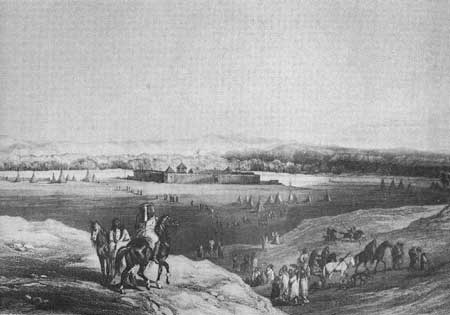|
The Upper Missouri Fur Trade Its Methods of Operation |
 |

Fort Union, at Mouth of the Yellowstone, from Bodmer
UNTIL well in the 19th century, the fur trade was the principal business on the Missouri River and its tributaries. In common with much of the frontier of the United States, here the trapper and trader preceded and prepared the way for the cattleman, the miner, and the pioneer farmer.
For several centuries the traders on the frontier found a ready market for furs and skins both on the eastern seaboard and in Europe. These were used in making beaver hats for aristocratic gentlemen and luxurious coats for their ladies. The skins of beaver, ermine, muskrat, deer, otter, fox, and mink were very much in demand. Buffalo hides, converted into coats and robes, became important items in the trade until the bison were extirpated in the 1870's and 1880's.
Not long after Father Jacques Marquette and Louis Joliet discovered the mouth of the Missouri in 1673, adventurous French traders and coureurs de bois, from Louisiana and the Great Lakes Region, began to push their canoes up its muddy waters in search of the precious peltries. By the end of the French occupation in 1763, they had reached above the mouth of the Platte and perhaps as far as the Niobrara. Captain Philip Pittman wrote in 1767 or 1768 that French traders go "betwixt three or four hundred leagues up" the Missouri and "this branch of commerce is considerable." He added that this business "employs annually eight thousand pounds worth of European goods" and the trade returns "are certain of two hundred per cent profit." [1]
In the first two decades of the Spanish regime, traders operating under that government advanced little farther up the Missouri, than had the French. However, when the powerful English companies, the Hudson's Bay Company, a monopoly chartered by the British Crown in 1670, and its principal competitor, the Northwest Company of Montreal organized in the 1780's, began to press into the Upper Mississippi and Missouri regions Spain decided to send its own traders to counteract this rival influence. In 1794 French traders of St. Louis, operating under a Spanish license, organized the Company of Explorers of the Upper Missouri. This company sent out three expeditions, the third of which, led by James MacKay in 1795, reached the Mandan villages above present-day Bismarck, North Dakota. There he found British traders whom he ordered to leave the country. The end of Spanish domination in 1802 left the trade of the Upper Missouri, from the mouth of the Platte to the Yellowstone and Bighorn Rivers, in British hands. [2]
Before the United States had acquired Louisiana President Thomas Jefferson, probably with the view of wresting the control of the region from the British, took initial steps toward exploring the Missouri River to the mountains and finding a route to the Pacific. The purchase of Louisiana was consummated in 1803, and the following year in accordance with their instructions, Captains Meriwether Lewis and William Clark and 48 young frontiersmen, set out on their epic journey to the Pacific. Enroute they mentioned passing both existing and abandoned posts. On their return trip from the Pacific two years later, they encountered two American trappers above the Mandan villages. Before they reached the mouth of the Platte they met several trading parties going into the Indian country.

|

|
|
|
|
Last Modified: Sat, Jan 15 2005 10:00:00 am PDT |


